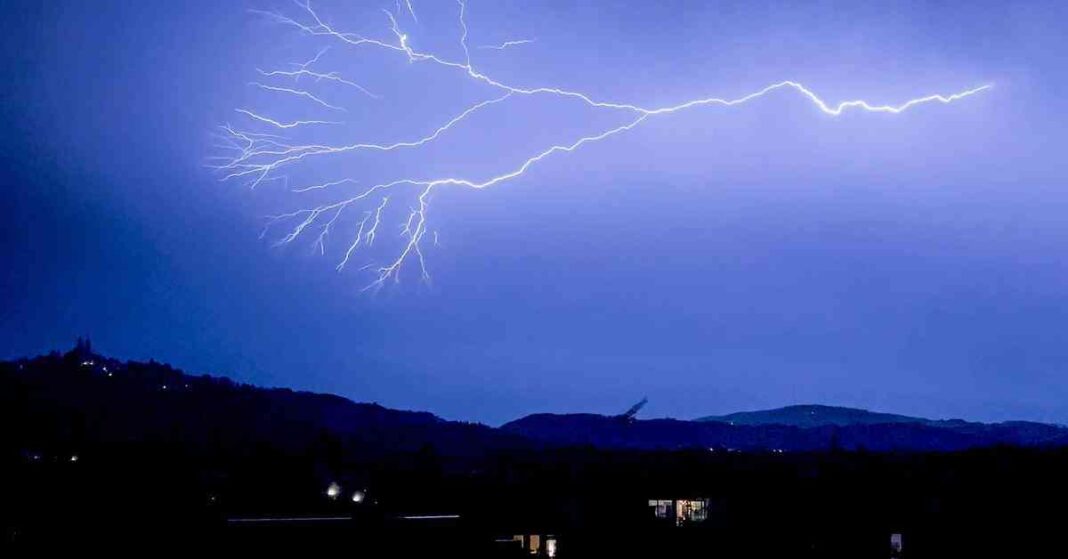Severe Weather Strikes Austria: Trains Stranded, Dog Struck by Lightning
Severe weather wreaked havoc in parts of Austria on Monday evening, with intense thunderstorms bringing heavy rain, hail, and lightning. The rapid onset of the storms led to a flurry of emergency responses, with Tyrolean fire departments responding to 150 incidents and Salzburg’s to nearly 240. The extreme weather triggered mudslides, causing road closures, and lightning strikes sparking fires.
Trains Stranded on Karwendel Railway
The Karwendelbahn railway line was one of the casualties of the severe weather, as two trains carrying a total of 40 passengers became stuck due to a mudslide. The first affected train was traveling from Innsbruck to Seefeld when it was halted by the debris. Efforts to evacuate the passengers were complicated by a second mudslide, blocking the path of a rescue train. Emergency personnel had to hike to the stranded train, eventually enabling it to return to the Westbahnhof station in Innsbruck. The passengers were then transferred to awaiting rescue teams for further assistance.
The second train, headed towards Innsbruck, also faced challenges in safely disembarking passengers. With the help of the fire department, passengers were able to exit the train and were subsequently transported to their destination. The Karwendelbahn line is expected to remain closed for repairs, with a rail replacement service established between Innsbruck and Seefeld.
Roads Blocked and Vehicles Trapped
The Tiroler Straße (B171) between Zirl and Innsbruck bore the brunt of the mudslides, trapping ten vehicles with 17 occupants. As emergency crews worked to clear the road, a joint effort with geologists was initiated to assess the extent of the damage and plan for cleanup operations. The closure of the affected stretch of road necessitated alternative routes via the Inntalautobahn (A12) or the Völser Straße (L11) for commuters.
In a separate incident, a bus accident occurred in Kematen, Innsbruck-Land district, when a bus struck a raised manhole cover during the storm. The abrupt impact caused injuries to the 32-year-old driver and a 44-year-old passenger, highlighting the dangers posed by the severe weather conditions.
Muren and Landslides Disrupt Travel
Throughout Tyrol and Salzburg, numerous roads were affected by mudslides and landslides, impeding travel and posing risks to motorists. The Oberinntal Landesstraße and the Pitztal Straße were among the routes temporarily closed due to debris, while the Großarler Landesstraße in Pongau required maintenance to become passable again. The Wagrainer Bundesstraße remained shut following an incident where three vehicles were trapped by mudflows, necessitating a rescue operation by the fire department.
In Salzburg, the Pinzgau and Pongau regions experienced significant storm damage, with lightning strikes igniting fires and causing widespread destruction. The efforts of over 1000 firefighters across 31 departments were crucial in managing the aftermath, including the containment of blazes and the clearance of blocked roads.
Blazes and Injuries from Lightning Strikes
The menacing thunderstorms in Austria led to several instances of lightning strikes causing fires and injuries. In Bramberg am Wildkogel, a lightning bolt struck a mountain farmhouse, triggering a major firefighting operation to extinguish the flames. Similarly, reports emerged from Unken and Wald in Pinzgau of wildfires suspected to have been ignited by lightning strikes.
In the Tennengau district, two hunters encountered a close call with lightning while seeking shelter from the storm. Despite sustaining minor injuries, the men survived the ordeal, unlike their loyal companion, a hunting dog who sadly perished in the lightning strike.
Recovery Efforts and Ongoing Challenges
As authorities and emergency services continue to assess the impact of the severe weather in Austria, the focus remains on cleanup and restoration efforts. In Vorarlberg, a mudslide in St. Gallenkirch necessitated the closure of the Gargellener Straße (L192), prompting a coordinated response to clear the route and address localized disruptions within the town.
Niederösterreich also faced its share of weather-related incidents, with approximately 90 emergency responses recorded in the Himberg and Ebergassing areas. Firefighters worked tirelessly to address flooding and debris accumulation, underscoring the widespread effects of the powerful storms.
Conclusion
The severe weather events in Austria serve as a stark reminder of nature’s unpredictability and the importance of preparedness in the face of adversity. While the immediate impacts have been felt through disrupted transport and property damage, the resilience and swift actions of emergency responders offer hope for a swift recovery. As communities band together to overcome the challenges posed by the storms, the collective efforts to rebuild and restore normalcy underscore the unwavering spirit of solidarity in times of crisis.















